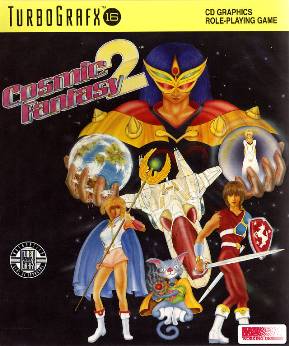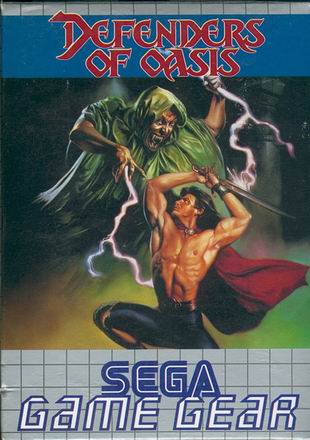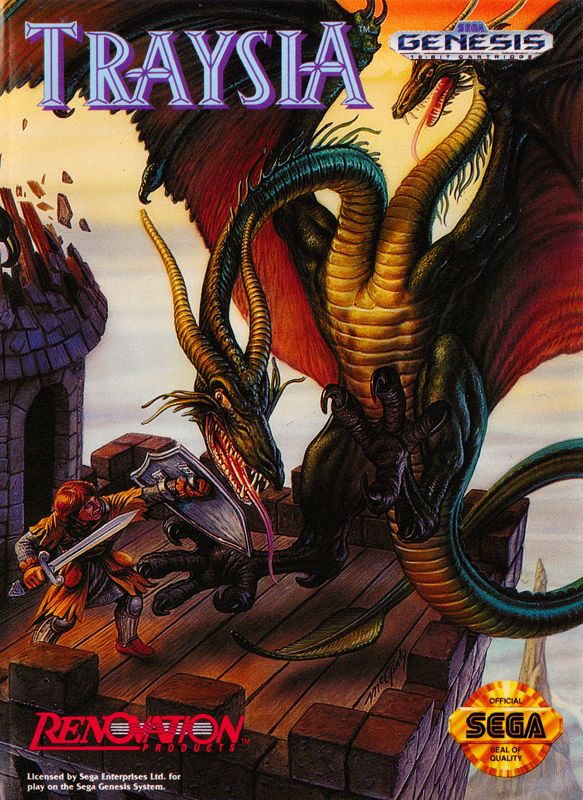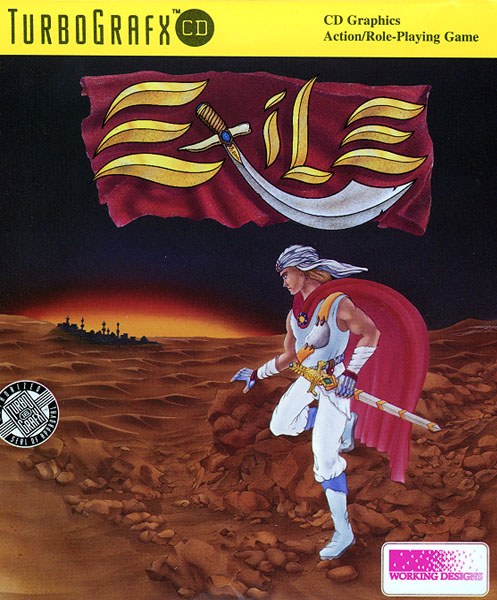Game 47
Title:
Lagoon
Released:
December 1991
Platform:
SNES
Developer:
Zoom
Publisher:
Kemco
Genre:
Action-RPG
Exploration -
Top-down
Combat -
Real Time Action
Series -
Standalone
 |
| Was it all just a fairy tale? |
These were really the formative years for my perception on console RPGs. Final Fantasy II was great, and I even had fun playing Drakkhen. Lagoon was a short game we rented that I ended buying with my own money because I enjoyed it so much. I don't know if it was the music, the graphics, or the jumping, but something about it resonated with me. The music has a synth motif reminiscent of tunes one might attribute to the Genesis. It's only years later that I'd come to find that this, and Drakkhen, were considered bad games by the majority of opinions on the Internet.
 |
| They're probably bathing in it |
The story begins with Nasir's mentor, Mathias, instructing him on his destiny. Muddy water drives the plot, and of course there's those demons everywhere. Nasir arrives in Atland to investigate a way to purify the water, and rid the land of demons. There's a short intro sequence that showed a princess, and a man known as Thor that had one red eye and one blue. While traveling in this monster infested land, Nasir failed to realize he should bring a weapon, or armor. So, we arrive in Atland with nothing but the clothes on our back.
 |
| *Plop* |
The townspeople pointed me towards the mayor, who helpfully funded an expedition into a nearby cave after a man was found badly wounded outside told a tale of a man named Giles trapped within. With some gold in my pocket I purchased a short sword, bandit armor, and an iron shield. The cave was a twisty maze of passages that all looked alike. Combat is a little difficult to get a handle on; the sword has such a tiny range that I found myself running into the enemy more often than actually connecting with it. Unfortunately, that caused damage to Nasir. With a shield I sometimes naturally deflected those hits, but Nasir was wide open while swinging his sword.
 |
| Damage causes knock-back, which makes it hard to connect multiple times |
Experience and gold increased after defeating an enemy, and there's no real fanfare for leveling up either. HP and MP naturally regenerate while standing still, so the game isn't too difficult with some caution. I found Giles on the mountain top, but he was badly hurt and asked for a healing pot. The first time I tried to give it to him I accidentally pressed the button to use it on myself. I can just imagine the scene, Nasir slowly drinks the potion down to the last drop right in front of him. I purchased another from the item shop, and retrieved him. He followed me back to town at a snail's pace. Once I returned him, Giles pointed me to the faith healer. She told me that a demon named Samson lay behind a locked door in the cave, and gave me the key.
 |
| This is how close I have to be to hit him |
I gained the fire crystal after defeating him. Magic is equipped by selecting a crystal and staff. The combination allows the use of one spell at a time. An old man in Voloh directed me to find three tablets that could unseal Philips Castle. The mayor provided me the earth staff (combined with the fire crystal gave me the fireball spell) as well as an item to free his people from the castle. The store didn't have much for sale, but there was an overpriced Shiny
Ball (10,000 gold), which was said to increase regeneration. There's no way I was
going to afford that; I don't think I had that much even by the end of the game. Oh, and some princess named Felicia disappeared. A man named Zerah appeared to be the main antagonist, and was seen right before her disappearance. Thor was in town, and he gave me his third of the tablet as well as helped me find the tablet hidden in the plains. The last was just outside Philips Castle.
 |
| Let's be honest, who else has forgotten there was a jump button by this point and walked off the bridge? |
With all three tablets found, the old man in Voloh translated the spell (Hieke Larmerila Kemuhi--I wonder if this is just gibberish, or is meaningful to someone) to unlock Philips Castle. Thor had his own business to attend to and left. Inside the castle I found some gold armor and keys to the prison. Once inside the prison, I used the mantle on the elf prisoners who rewarded me with the key to the boss room. I picked up a large shield along the way, and then found myself facing a two-headed lion with wings on the roof. This was the first real challenge, and I'm glad I remembered I to save just outside its door. Magic doesn't work on bosses, and regeneration is halted while fighting them. Items can still be used, but only one of each can be carried, so there's no chance to stock up on potions.
 |
| After defeating this boss I learned its name was Natela |
Killing off Natela rewarded my with a silver sword and unlocked a door on the side of the castle, which housed a passage to the Dwarf Desert. I picked up the Sonic Armor in Denegul, the next village over, but had to put off the purchase of the Great Shield until another time. One of the old men in town provided an ancient book about a moon blade, made of moon stone, and the sky staff. I ran into Thor who lost his pendant back in Voloh, and he asked me to retrieve it. There's no fast travel, so I had to trek back and forth. One of the elves had the pendant. Thor exchanged the pendant for a powerful mirror, which destroyed a couple large rocks outside the Dwarf Cave. Inside was a wind crystal, magic sword, and a protective ring. Rings constantly drain MP, so they're great for boss battles, but not much else.
 |
| Oh, yeah, and I picked up some stone too, which I promptly forgot about |
Back in Denegul, Mathias appeared to tell me that the princess Felicia was taken by Ella, who works for Zerah. She escaped through the Dwarf Cave. I showed the moon stone to one of the dwarves as requested, and was rewarded with the freezing pot. That allowed me to freeze a lava flow in the Dwarf Cave, which was the hardest area in the game. Having to go through it three times didn't make it any easier. On the other side was Felicia, being dragged off by Ella. She asked me to save her before they could use her power to move Lagoon Castle, the source of all water. I chased after Ella, but ran into her pet instead. This rock monster was only vulnerable while its eye-stalks poked out.
 |
| I never really understood pet rocks, but this one was named Eardon |
The next town was suffering from a disease assumed to have come from the muddy water. The priest in Poper asked me to retrieve some mint from Siegfried Castle. He'd go himself, but you know, demons. The enemies there weren't much trouble, and I came away with a maxim shield, thunder armor, and the mint. I was then directed to some spirits underneath the chapel. The thanked me, but also issued a warning of the coming battle between light and dark. I received the star staff, and a key to Duma's room, the next boss guarding the path to Lagoon Castle. On my way there I collected the force sword, and two more rings. Duma could crush with his hands, and his face was only vulnerable during a short time when his mask was open.
 |
| I took a lot of damage from being crushed |
The power ring was my ring of choice. I gained the water crystal and key of Siegfried for my trouble. At the back entrance of the castle I ran into Thor, apparently working for the bad guys. I watched helplessly as Lagoon Castle rose to the sky on a pillar of water. At least they left a teleportation pad to Lilaty, home of little people. They spoke of an ice cave that required a fur mantle, which was held by a big liar. Someone gave me a fire of truth to smoke him out. Without the fur mantle equipped, the ice cave causes constant damage. Before I headed in, I also gained an angel's bell to awaken some nymphs. Hugging the walls led me to the boss room where I faced a huge snowball, named Thimale. Definitely one of the more difficult battles, but mostly due to not knowing its weak spot. I first had to destroy some ice pillars, and then place myself in such a way as to attack the ball without getting hit.
 |
| Then they blew me away to Phantom Hill |
Nymphs were waiting on the other side. They gave me the moon staff before sending me off to Phantom Hill in pursuit of Zerah. This hill was sparsely decorated. The only notable feature was a small hole where Ella was hiding out. Ella was another tough battle. She would teleport randomly, and spray out fireballs. The more damage she took, the faster she went. Defeating her made stairs appear. At the summit I watched as Zerah and Mathias faced off in a heated battle. Zerah escaped, but Mathias was mortally wounded. He revealed that Thor and Nasir were sons of the gods, one light and one dark. What's with these games where a big reveal is that the bad guy is related to the good guy? With the last of his strength, he passed on the thunder crystal, and blew me away to the clouds.
 |
| Only some clouds can support Nasir, others are death |
At the end of the clouds, I leaped on to the floating island supporting Lagoon Castle. At the threshold, I read a message that the moon stone could be used in the moonlight to create the moon blade. By this point though, I had completely forgotten I already had the moon stone. So, I scoured Lagoon Castle multiple times looking for it. I found the moonlight early on, rescued the king and queen, and rescued the princess from a magic mirror. I found a healing ring, the moon armor, and defeated Battler (a magician with two powerful minions). Battler teleported around while his minions stalked the room in a set pattern.
 |
| Somehow I ended up getting a double KO on him one time, note the full health bar that is filled after defeating a boss |
Beyond Battler was an island where the evil spirit was revived. Inside the cave I found the time ring, a mostly useless item. I was still searching desperately for the moon stone, so after exhausting all paths in that cave I returned to Lagoon Castle. I found the moon shield, and then finally, I thought I could defeat the final boss without the sword. I gave it a valiant effort. The final boss consisted of multiple battles. First a large head inside a bubble, then a gargoyle with a whip, then Zerah, then Thor (two forms), and finally a red gargoyle. However, the game let me fight through all of these monsters without trouble up until the red gargoyle, which only took damage from the moon sword.
 |
| This is Thor's final form; why can't I turn into a bird? |
Thor and Nasir shared a touching reunion as Zerah's control was broken. Thor's soul entered his pendant ("by the power of the secret place") as his body died. I tried to fight the red gargoyle many times before I finally resolved myself to returning to the moonlight. I then remembered, with the help of my chat, that I had already picked up the moon stone four hours earlier. With the moon blade, I easily defeated the red gargoyle, and was congratulated by the disembodied voice of Nasir and Thor's father. The game ended in a montage of cut-scenes, and the final screen seen above.
Elapsed Time: 7
h36
m (
Final Time: 7
h36
m)
 |
| This screams sequel, doesn't it? |
Combatant - Combat was often more aggravating than challenging. Getting into the right position to connect with the small sword was the biggest issue. Magic is available, but quickly becomes useless by either adding long wait times to allow for regeneration or are completely ineffectual. Enemies are varied, but lack animation. Rewards are well paced, and max level just out of reach without grinding. Although an action game, stats play a large role.
Rating:
5
 |
| Lagoon Castle returned to it's rightful place |
Admirer - There aren't any additional abilities, but magic is customized based on personal preference. In the end, everyone has the same character. Equipment alters appearance, but if you're not using the latest piece then you're going to have a bad time. Controls are a bit stiff, and there aren't any advancement options.
Rating:
3
 |
| Nasir remembered his lost brother |
Puzzler - No puzzles to speak of, although it's puzzling how I could forget I had a certain item. The main quest does well to remind the player of what to do next. No side quests, and no alternative paths through the challenges.
Rating:
1
 |
| Thor's strange eyes stare into my soul |
Instigator - The story is a bit strange. While investigating muddy water at the furthest point from the source, we get wrapped into evil plans to be evil. A princess is kidnapped, and great demons are summoned (to stand idly by in dungeons). The NPCs do well to inform the player, but the game lacks descriptions for items and any way to alter the course of events. To move the story along I was often seeking out bosses without really knowing what purpose lay beyond. All in the name of good I suppose.
Rating:
3
 |
| I guess Nasir hooks up with the princess |
Collector - There's lots of stuff, but most of it isn't optional. Getting the Shiny Ball is probably the true collector's task. The economy keeps a nice balance throughout, and there's a slot in inventory for every item. Only one of each can be had at any time though.
Rating:
6
 |
| The final screen pans up to the moon before the book closes |
Explorer - The graphics are bland, and lack detail. The music was well done however, and I was surprised to hear such sounds come from a SNES game. The world doesn't offer much reward for exploration, although the background in Phantom Hill is nice. There's definitely not much to write home about. This was a port from the X68000, and it shows how little was done to enhance the experience.
Rating:
3
Final Rating:
21 [35%]
 |
| The intro sequence made it seem like Nasir and Thor work together |
Overall, I had fun. I can see why some might not like the experience; it's definitely a bit trying on the patience with such a small weapon. The lack of magic against bosses limits combat strategy a bit. I just have such good memories of the game as a child that are hard to separate my bias from spilling into the review. It's a fun little action RPG, and at about 6 hours I think it's doable for most fans of the genre. Definitely not a good choice for a first time, and easily skipped by most.
Next up, I have a couple games to cut, and then we'll wrap up 1991 with Crystal Warriors. That's a game I had no experience with going in, and it turned out to be one of the easiest games I've had to date with a little thanks from a strange max level "bug."


















 Cowboy Kid - An RPG? No, definitely not. Although not listed as an RPG on MobyGames at this time, it was at one point, so it could be listed as one somewhere else. There's no character development, some NPCs, but not a lot of story or world exploration.
Cowboy Kid - An RPG? No, definitely not. Although not listed as an RPG on MobyGames at this time, it was at one point, so it could be listed as one somewhere else. There's no character development, some NPCs, but not a lot of story or world exploration.  Gemfire - A strategy game limited to a single map. Released on Genesis, NES, and SNES, it was one of the first to offer generals that had specialized units. With more in common with Romance of the Three Kingdoms than Warsong, it's hard to say why someone would consider this an RPG rather than a simulation-strategy game.
Gemfire - A strategy game limited to a single map. Released on Genesis, NES, and SNES, it was one of the first to offer generals that had specialized units. With more in common with Romance of the Three Kingdoms than Warsong, it's hard to say why someone would consider this an RPG rather than a simulation-strategy game. Legend of Zelda: A Link to the Past - This was a great game, and I enjoyed discovering every bit of it as a kid. However, I never felt it had very much in common with games I considered RPGs. Maybe that had to do with my experience in Bard's Tale and Wizardry before this time. I enjoy these games a lot, but to compare them to Final Fantasy, Arcana, or even Ys seems a bit off.
Legend of Zelda: A Link to the Past - This was a great game, and I enjoyed discovering every bit of it as a kid. However, I never felt it had very much in common with games I considered RPGs. Maybe that had to do with my experience in Bard's Tale and Wizardry before this time. I enjoy these games a lot, but to compare them to Final Fantasy, Arcana, or even Ys seems a bit off. Ninja Taro - I'm not sure how this was ever considered an RPG, but someone made a terrible mistake. In fact, I think the mistake was even making this game. The game seems to use the same engine as Rolan's Curse, but somehow manages to have even less features.
Ninja Taro - I'm not sure how this was ever considered an RPG, but someone made a terrible mistake. In fact, I think the mistake was even making this game. The game seems to use the same engine as Rolan's Curse, but somehow manages to have even less features. Rolan's Curse II - The second in the series doesn't do anything to add to the score for the RPG scale. There are a couple more sub-weapons, but the world is built in the same way.
Rolan's Curse II - The second in the series doesn't do anything to add to the score for the RPG scale. There are a couple more sub-weapons, but the world is built in the same way.  Spiritual Warfare - An action adventure similar to Zelda once again gets confused as an RPG. This wasn't even technically a licensed title, but I thought I'd cover it. There's no character advancement, and the story is minimal.
Spiritual Warfare - An action adventure similar to Zelda once again gets confused as an RPG. This wasn't even technically a licensed title, but I thought I'd cover it. There's no character advancement, and the story is minimal.  Tecmo Cup: Soccer Game - Probably the closest for consideration, I don't think this quite meets all the criteria. This is a turn-based soccer game where the characters gain strength after a game. Using special moves to get past the other team and score goals is the only strategy I see. I believe the game lacks an economy, NPCs, or a world to explore.
Tecmo Cup: Soccer Game - Probably the closest for consideration, I don't think this quite meets all the criteria. This is a turn-based soccer game where the characters gain strength after a game. Using special moves to get past the other team and score goals is the only strategy I see. I believe the game lacks an economy, NPCs, or a world to explore. Ultima: Runes of Virtue - This appears to be yet another Zelda-like action-adventure. Like others character advancement is minimal, and is reliant more on player reflexes to settle combat. The departure from the standard Ultima model seems strange, and I'm curious to know more about it, but not enough to give it full coverage.
Ultima: Runes of Virtue - This appears to be yet another Zelda-like action-adventure. Like others character advancement is minimal, and is reliant more on player reflexes to settle combat. The departure from the standard Ultima model seems strange, and I'm curious to know more about it, but not enough to give it full coverage.







































